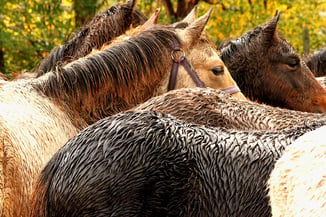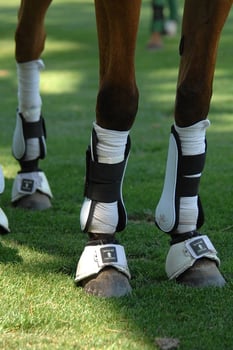Call us today (800) 444-7430
Call us today (800) 444-7430
 Treatment is fairly straightforward. Gently wash the area with an antibacterial soap or solution, then thoroughly dry – both the hair and the skin. It is important to keep the area around the pastern clean and dry to prevent reinfection. It may help to clip the hair around the pastern and apply a thick ointment to help protect the pastern as well as remove the scabs and promote healing. If the area doesn’t heal in a couple of weeks, contact your veterinarian to see if stronger medications or cleaning solutions are necessary.
Treatment is fairly straightforward. Gently wash the area with an antibacterial soap or solution, then thoroughly dry – both the hair and the skin. It is important to keep the area around the pastern clean and dry to prevent reinfection. It may help to clip the hair around the pastern and apply a thick ointment to help protect the pastern as well as remove the scabs and promote healing. If the area doesn’t heal in a couple of weeks, contact your veterinarian to see if stronger medications or cleaning solutions are necessary.
 -Be kind to pasterns. Bell boots are helpful in preventing horses from stepping on their front pasterns with their back feet, but make sure the boots fit properly and do not rub, causing irritation. Once a horse gets his legs wet from walking through a puddle or wet grass, everything seems to stick to them. Sand from an arena can also cause irritation if it isn’t brushed off before putting on leg wraps or boots. Also, if your horse has been standing in mud, be sure to brush or wash his legs off. It is important to thoroughly bathe/clean your horse but make sure you don't become too aggressive in cleaning the pastern areas. Remember that too much water will soften the skin and make it inviting for bacteria. Brushing dried mud with a stiff brush can cause those tiny cuts through which bacteria love to enter. Finally, some people like to keep the pastern area neat and clean by clipping – just make sure the clippers are clean and you don’t nick this sensitive area.
-Be kind to pasterns. Bell boots are helpful in preventing horses from stepping on their front pasterns with their back feet, but make sure the boots fit properly and do not rub, causing irritation. Once a horse gets his legs wet from walking through a puddle or wet grass, everything seems to stick to them. Sand from an arena can also cause irritation if it isn’t brushed off before putting on leg wraps or boots. Also, if your horse has been standing in mud, be sure to brush or wash his legs off. It is important to thoroughly bathe/clean your horse but make sure you don't become too aggressive in cleaning the pastern areas. Remember that too much water will soften the skin and make it inviting for bacteria. Brushing dried mud with a stiff brush can cause those tiny cuts through which bacteria love to enter. Finally, some people like to keep the pastern area neat and clean by clipping – just make sure the clippers are clean and you don’t nick this sensitive area.

From horse stalls to barn doors, stable flooring and entrance gates, Classic offers the widest product lines in the industry while continuing to expand through innovation and strategic alliances.
We look forward to answering your questions. Our sales team is knowledgeable about everything from horse barn design to equine stall systems and readily available to assist you in planning your Classic barn!
ph: (800) 444-7430
em: sales@classic-equine.com
